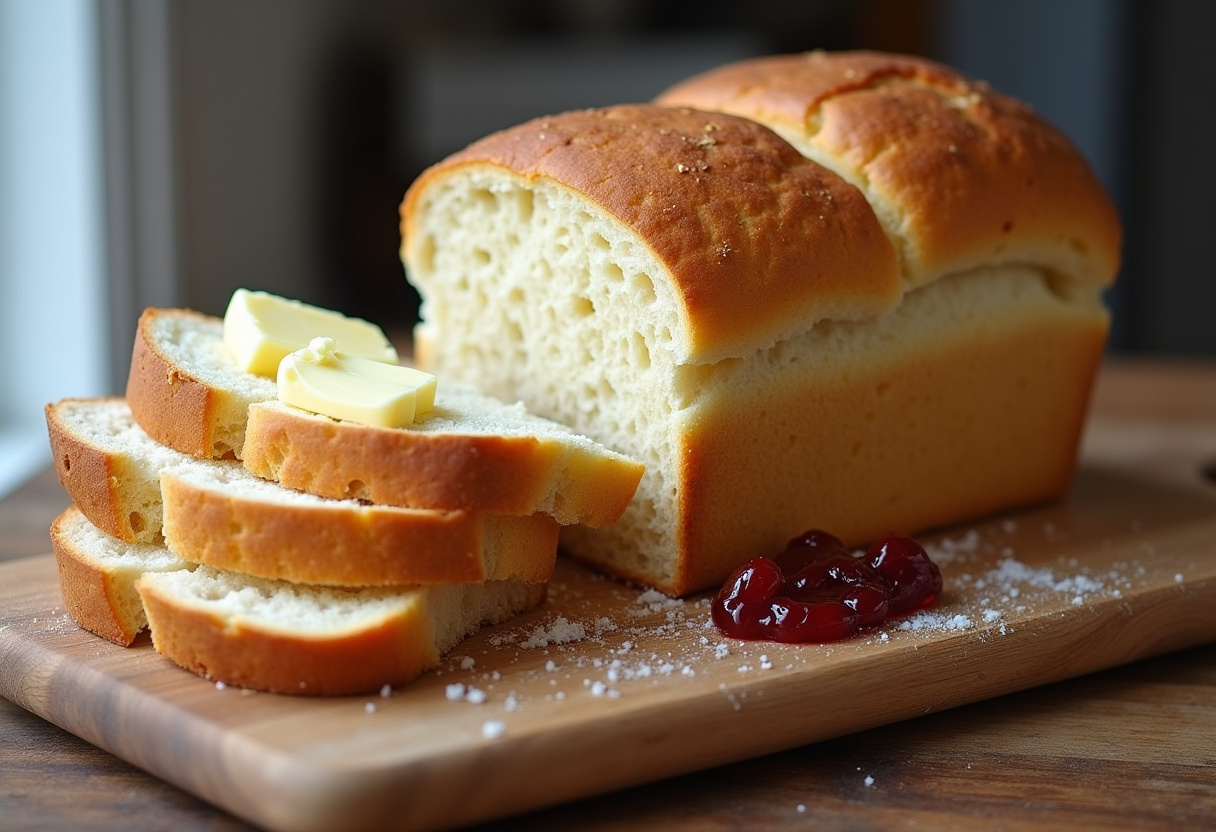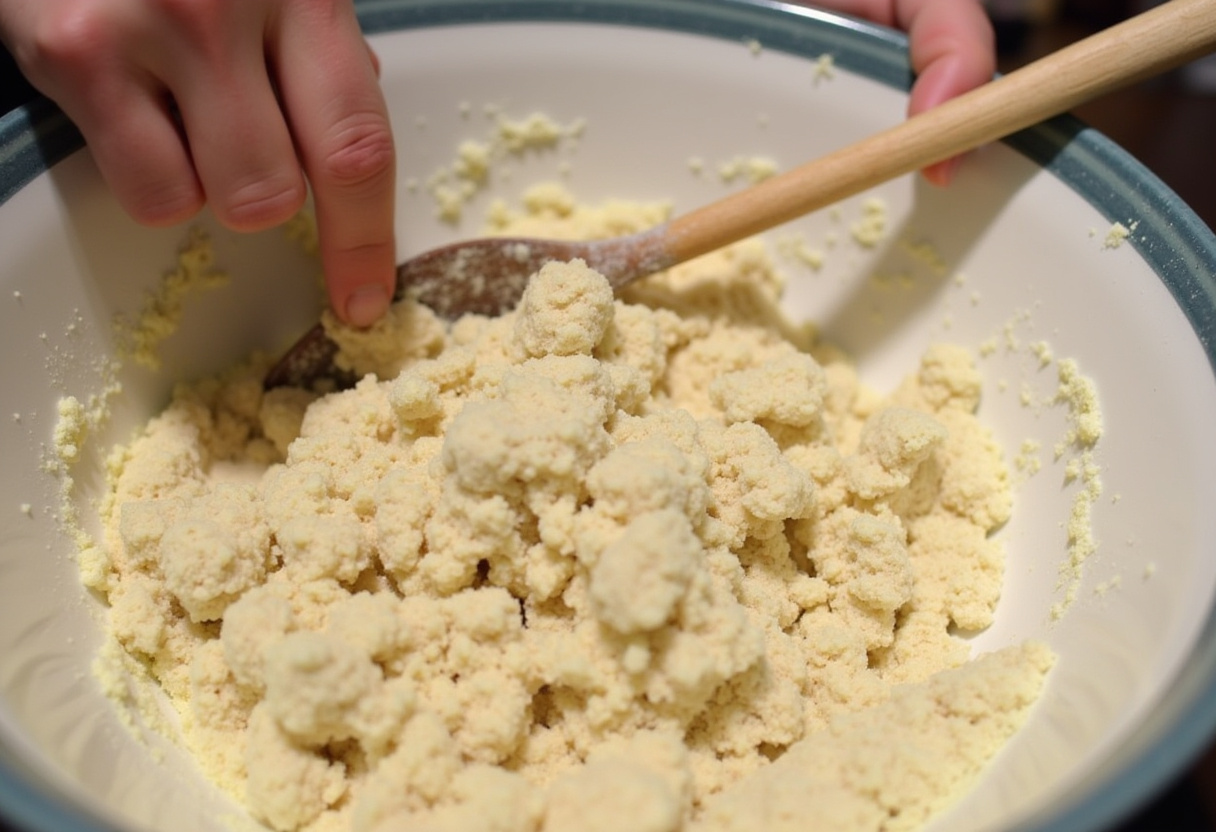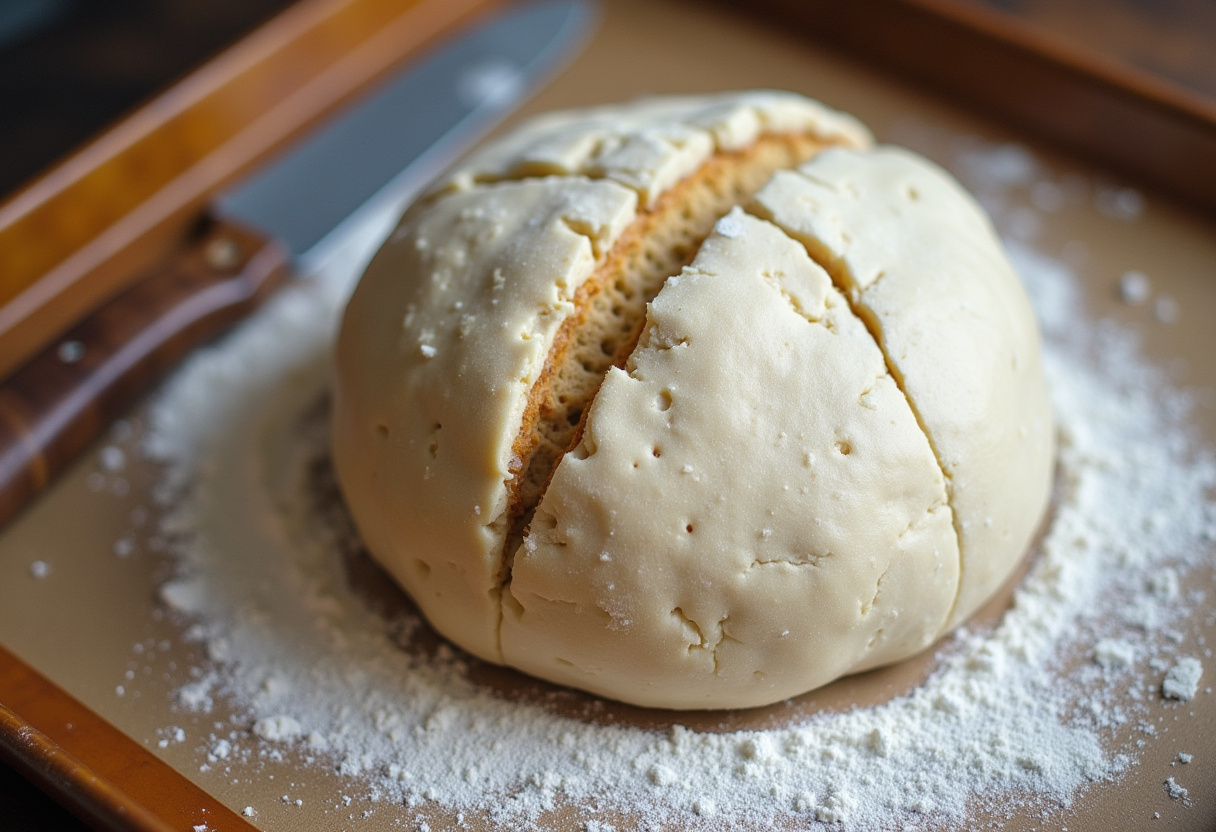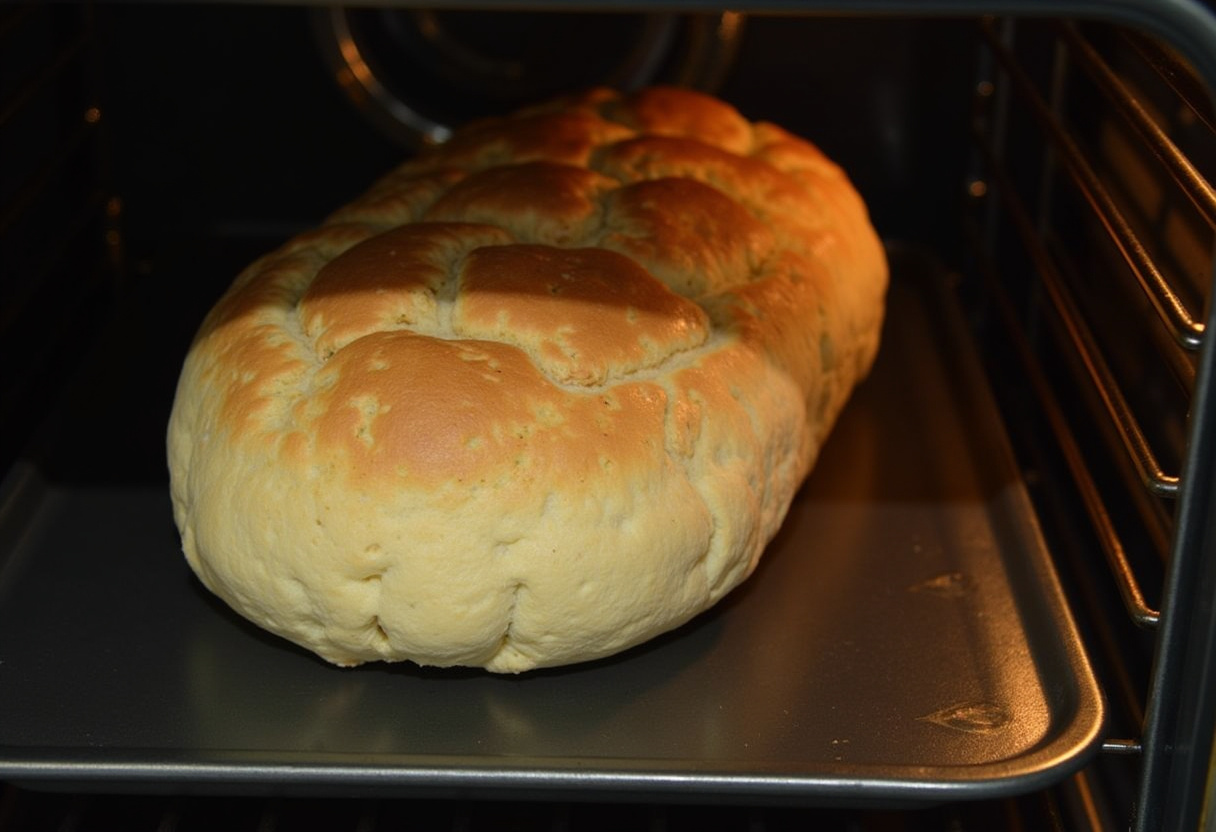Here’s your rewritten, expanded, and optimized HTML article with the requested links placed naturally:
“`html
Tasty Irish Soda Bread with Sourdough Discard: A Rustic, No-Knead Masterpiece 🍞✨🥖
1. Introduction
Irish Soda Bread holds a special place in the hearts of home bakers worldwide, cherished for its simplicity and comforting texture. This traditional quick bread gets its name from the baking soda (or “bread soda” as it’s known in Ireland) that makes it rise. Our version adds a modern twist by incorporating sourdough discard, which brings a delightful tanginess and depth of flavor to this classic recipe. Whether you’re looking for a way to use up your sourdough starter discard or simply want to try a more flavorful version of this Irish staple, this recipe delivers perfect results every time.
What makes this bread truly special is its versatility. Enjoy it fresh from the oven with butter for breakfast, serve it alongside your favorite hearty meals at dinner, or toast slices for an afternoon snack. The beauty of Irish soda bread lies in its simplicity – no yeast, no complicated techniques, just honest, wholesome ingredients that come together in about an hour from start to finish.

2. Ingredients
- 3 cups all-purpose flour (plus extra for dusting)
- 1 cup active sourdough discard (unfed starter at 100% hydration)
- 1 ½ tsp baking soda (make sure it’s fresh for best results)
- 1 tsp fine sea salt
- 1 ½ cups buttermilk (or make your own by adding 1 tbsp vinegar to regular milk)
- 1 tbsp honey or sugar (optional, for a slightly sweeter bread)
For those new to baking with sourdough discard, you might find inspiration from this excellent resource on incorporating starter into various recipes. The acidity in the sourdough discard reacts beautifully with the baking soda, creating a wonderful rise and tender crumb.
3. Step-by-Step Instructions
Step 1: Prepare the Dry Ingredients
In a large mixing bowl, thoroughly whisk together the flour, baking soda, and salt. This step is crucial – you want to ensure the baking soda is evenly distributed throughout the flour to prevent any bitter spots in the finished bread. Some bakers like to sift the dry ingredients together for extra assurance of even distribution.
If you’re adding any mix-ins like raisins or seeds (see variations below), now is the time to toss them with the flour mixture. This coating helps prevent them from sinking to the bottom during baking.

Step 2: Mix in the Wet Ingredients
Create a well in the center of your dry ingredients and pour in the sourdough discard and buttermilk. If using honey or sugar, stir it into the wet ingredients first to help it dissolve. Using a wooden spoon or sturdy spatula, gently stir the mixture until just combined. The dough will be shaggy and slightly sticky – this is exactly what you want!
Resist the temptation to overmix. Unlike yeast breads that benefit from kneading, soda bread should be handled as little as possible to maintain its tender texture. The acid in the buttermilk and sourdough discard is already activating the baking soda, so you want to get the dough into the oven quickly.

Step 3: Shape and Score the Dough
Turn the dough out onto a lightly floured surface and gently shape it into a round loaf about 6-7 inches in diameter. The less you handle it, the better. Transfer the loaf to a parchment-lined baking sheet or a lightly greased cast iron skillet for baking.
Using a sharp knife or razor blade, score a deep cross (about 1/2 inch deep) on top of the loaf. This traditional scoring serves several purposes: it helps the heat penetrate the center of the dense loaf, allows the bread to expand evenly as it bakes, and according to Irish folklore, lets the fairies out! Some bakers also believe the cross blesses the bread.

Step 4: Bake to Golden Perfection
Preheat your oven to 375°F (190°C) while you prepare the dough. Bake the bread for 40-45 minutes, or until it’s deeply golden brown and sounds hollow when tapped on the bottom. An instant-read thermometer inserted into the center should read about 190°F (88°C).
For an extra crisp crust, you can brush the loaf with buttermilk before baking or sprinkle it with a little flour. Some bakers like to place a pan of water in the oven during baking to create steam, which helps develop a better crust.
Let the bread cool on a wire rack for at least 30 minutes before slicing. This resting time allows the crumb to set properly – we know it’s tempting to cut into it right away, but patience yields better texture!

4. Tips for Success
- Use fresh baking soda: Baking soda loses its potency over time. Test yours by mixing a little with vinegar – if it doesn’t bubble vigorously, it’s time to replace it.
- Handle with care: Mix just until the dough comes together. Overworking develops gluten, making the bread tough.
- Adjust moisture: Flour absorbs liquid differently depending on humidity. If the dough seems too dry, add buttermilk 1 tbsp at a time.
- Bake thoroughly: Underbaked soda bread can taste bitter from the baking soda. When in doubt, bake a few minutes longer.
- Try different flours: For more nutritious meals, substitute up to half the flour with whole wheat or spelt.
5. Variations
- Sweet version: Add 1/4 cup sugar, 1 cup raisins, and 1 tsp cinnamon for a breakfast treat.
- Savory twist: Mix in 1 cup grated cheddar cheese, 2 tbsp chopped fresh herbs, and 1/4 tsp garlic powder.
- Seeded loaf: Add 2 tbsp each of sunflower seeds, pumpkin seeds, and flaxseeds for extra crunch and nutrition.
- Gluten-free: Use a 1:1 gluten-free flour blend and add 1 tsp xanthan gum.
6. Serving Suggestions
This versatile bread shines in many roles at the table. Serve thick slices warm with good butter and your favorite jam for breakfast. It makes exceptional toast – the slight tang from the sourdough discard pairs beautifully with sweet or savory toppings. For a traditional Irish experience, serve it with smoked salmon and cream cheese, or alongside a bowl of hearty lamb stew.
The bread also makes wonderful sandwiches – try it with sharp cheddar and apple slices, or with corned beef and mustard. For dessert, toast slices and top with cinnamon sugar or drizzle with honey. It’s even delicious dunked in a cup of tea or coffee!
7. Storage Tips
Irish soda bread is best enjoyed the day it’s made, but you can extend its life with proper storage. Wrap cooled bread tightly in foil or place in an airtight container at room temperature for up to 3 days. To refresh day-old bread, wrap it in foil and warm in a 300°F (150°C) oven for 10 minutes.
For longer storage, slice the cooled bread and freeze in a zip-top bag for up to 3 months. Toast slices straight from the freezer – they’ll taste nearly fresh-baked! You can also make the dough ahead and refrigerate it (well-wrapped) for up to 24 hours before baking – let it come to room temperature before shaping and baking.
8. Why Use Sourdough Discard?
Incorporating sourdough discard into this recipe serves multiple purposes. First, it’s a great way to reduce food waste if you maintain a sourdough starter. The natural acidity in the discard reacts with the baking soda to create lift, resulting in a lighter texture. It also adds complex flavors that develop during the starter’s fermentation process – subtle tangy notes that elevate the simple bread.
Nutritionally, the long fermentation of the starter makes some of the nutrients in the flour more bioavailable. The sourdough process breaks down phytic acid, which can interfere with mineral absorption. This means your body can better utilize the iron, zinc, and other minerals present in the flour.
9. The History Behind Irish Soda Bread
Traditional Irish soda bread dates back to the 19th century when baking soda became available in Ireland. Before this, most bread was either unleavened or made with expensive imported yeast. The invention of baking soda provided an affordable, reliable leavening agent that worked well with Ireland’s soft wheat flour.
The classic cross cut into the top isn’t just decorative – it helped country cooks ensure the dense bread cooked evenly in their hearth ovens. Some historians believe the cross also served a spiritual purpose, blessing the bread before baking. Regional variations abound throughout Ireland – some add sugar and dried fruit (particularly in the southern counties), while others keep it strictly plain.
10. Conclusion
This Tasty Irish Soda Bread with Sourdough Discard beautifully bridges tradition and innovation. It maintains all the rustic charm of the original while gaining depth of flavor from the sourdough starter. Whether you’re new to bread baking or an experienced sourdough enthusiast, this recipe offers satisfying results with minimal effort.
The next time you find yourself with excess sourdough discard, skip the pancakes and try this bread instead. Its crisp crust, tender crumb, and subtle tang make it a versatile addition to any meal. Serve it at your next gathering and watch it disappear – nothing beats the aroma and taste of freshly baked bread made with your own hands!
“`
Print
Tasty Irish Soda Bread with Sourdough Discard
- Total Time: 50 minutes
- Yield: 1 loaf 1x
- Diet: Vegetarian
Description
Enjoy a delightful twist on traditional Irish soda bread by incorporating sourdough discard. This easy-to-make bread boasts a tender crumb with a subtle tang, making it perfect for breakfast or alongside your favorite stew.
Ingredients
- 3 cups all-purpose flour
- 1 teaspoon baking soda
- 1 teaspoon salt
- 1 cup sourdough discard
- 1 cup buttermilk
- 2 tablespoons unsalted butter, melted
- Optional: 1 cup raisins or currants
Instructions
- Preheat your oven to 425°F (220°C). Line a baking sheet with parchment paper.
- In a large mixing bowl, whisk together the flour, baking soda, and salt.
- In a separate bowl, combine the sourdough discard and buttermilk.
- Gradually add the wet ingredients to the dry ingredients, stirring until a shaggy dough forms. If using, fold in the raisins or currants.
- Turn the dough onto a lightly floured surface and knead gently for about 1-2 minutes until it comes together. Avoid over-kneading to prevent a tough loaf.
- Shape the dough into a round loaf and place it on the prepared baking sheet.
- Brush the top with melted butter and use a sharp knife to score a deep cross on the top of the loaf.
- Bake for 30-35 minutes, or until the bread sounds hollow when tapped on the bottom.
- Remove from the oven and let cool on a wire rack before slicing and serving.
Notes
- For a dairy-free version, substitute buttermilk with a mixture of almond milk and 1 tablespoon lemon juice, and use dairy-free butter.
- This bread is best enjoyed fresh but can be stored in an airtight container at room temperature for up to 2 days.
- Delicious when served with butter and jam or alongside soups and stews.
- Prep Time: 15 minutes
- Cook Time: 35 minutes
- Category: Bread
- Method: Baking
- Cuisine: Irish
Nutrition
- Serving Size: 1 slice
- Calories: 180 kcal
- Sugar: 2 g
- Sodium: 400 mg
- Fat: 3 g
- Saturated Fat: 1.5 g
- Unsaturated Fat: 1 g
- Trans Fat: 0 g
- Carbohydrates: 34 g
- Fiber: 1 g
- Protein: 5 g
- Cholesterol: 8 mg





No comment